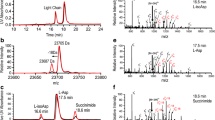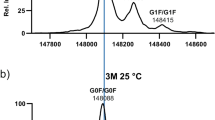ABSTRACT
Purpose
To identify and understand isomerization products and degradation profile of different aspartate residues in an IgG1 monoclonal antibody.
Methods
Recombinant IgG1 was incubated for extended periods of time in a formulation buffer at recommended and accelerated storage temperatures. Isomerization reaction products were analyzed using ion exchange chromatography (IEC), hydrophobic interaction chromatography (HIC), peptide mapping, and LC-MS. Model peptides with sequences containing specific aspartate residues in IgG1 were synthesized and incubated under accelerated conditions. Products of isomerization reactions of peptides were analyzed by reverse phase chromatography (RP-HPLC) and LC-MS. X-ray crystallography data from Fab of IgG1 were used to understand mechanism of isomerization reactions.
Results
A MAb containing labile Asp32-Gly sequence in CDR I region undergoes rapid isomerization reaction and leads to formation of isoaspartate (IsoAsp) and cyclic imide (Asu) forms. Isomerization of aspartate residues was observed in a non-CDR region containing Asp74-Ser sequence. Isomerization reaction at Asp74-Ser led to formation of Asu74 and trace isoAsp74. While isoAsp32 increased linearly with time, isoAsp74 did not increase during storage. Asu32 and Asu74 followed non-linear degradation kinetics and reached steady state over time. Isomerization reaction of two different model peptides containing Asp32-Gly or Asp74-Ser with neighboring amino acid sequences as those found in the MAb result in formation of IsoAsp.
Conclusions
Observed levels of Asu and trace IsoAsp at the Asp74 site are unusual for typical isomerization reactions. In addition to primary sequences, pKa, solvent exposure and high order structure around aspartate residues may have influenced isomerization reaction at Asp74 in MAbI. Different degradation profiles from the two Asp residues can influence shelf life and should be carefully evaluated during product development.













Similar content being viewed by others
REFERENCES
Vlasak J, Ionescu R. Heterogeneity of monoclonal antibodies revealed by charge-sensitive methods. Curr Pharm Biotechnol. 2008;9:468–81.
Chelius D, Rehder DS, Bondarenko PV. Identification and characterization of deamidation sites in the conserved regions of human Immunoglobulin Gamma antibodies. Anal Chem. 2005;77:6004–11.
Lam XM, Yang JY, Cleland JL. Antioxidants for prevention of methionine oxidation in recombinant monoclonal antibody HER2. J Pharm Sci. 1997;86:1250–5.
Joshi AB, Sawai M, Kearney WR, Kirsch LE. Studies on the mechanism of aspartic acid cleavage and glutamine deamidation in the acidic degradation of glucagon. J Pharm Sci. 2005;94:1912–27.
Perkins M, Theiler R, Lunte S, Jeschke M. Determination of the origin of charge heterogeneity in a murine monoclonal antibody. Pharm Res. 2000;17:1110–7.
Napper S, Prasad L, Delbaere LTJ. Structural investigation of a phosphorylation-catalyzed, isoaspartate-free, protein succinimide: crystallographic structure of post-succinimide His15Asp histidine-containing protein. Biochemistry. 2008;47:9486–96.
Terashima I, Koga A, Nagai H. Identification of deamidation and isomerization sites on pharmaceutical recombinant antibody using (H2O)-O-18. Anal Biochem. 2007;368:49–60.
Xiao G, Bondarenko PV, Jacob J, Chu GC, Chelius D. O-18 labeling method for identification and quantification of succinimide in proteins. Anal Chem. 2007;79:2714–21.
Cacia J, Keck R, Presta LG, Frenz J. Isomerization of an aspartic acid residue in the complementarity-determining regions of a recombinant antibody to human IgE: identification and effect on binding affinity. Biochemistry. 1996;35:1897–903.
Wakankar AA, Borchardt RT. Formulation considerations for proteins susceptible to asparagine deamidation and aspartate isomerization. J Pharm Sci. 2006;95:2321–36.
Oliyai C, Borchardt RT. Chemical pathways of peptide degradation .6. Effect of the primary sequence on the pathways of degradation of aspartyl residues in model hexapeptides. Pharm Res. 1994;11:751–8.
Harris RJ, Kabakoff B, Macchi FD, Shen FJ, Kwong M, Andya JD, et al. Identification of multiple sources of charge heterogeneity in a recombinant antibody. J Chrom B. 2001;752:233–45.
Xiao G, Bondarenko PV. Identification and quantification of degradations in the Asp-Asp motifs of a recombinant monoclonal antibody. J Pharm Biomed Anal. 2008;47:23–30.
Chu GC, Chelius D, Xiao G, Khor HK, Coulibaly S, Bondarenko PV. Accumulation of succinimide in a recombinant monoclonal antibody in mildly acidic buffers under elevated temperatures. Pharm Res. 2007;24:1145–56.
Brennan TV, Clarke S. Effect of adjacent histidine and cysteine residues on the spontaneous degradation of asparaginyl-containing and aspartyl-containing peptides. Int J Pept Protein Res. 1995;45:547–53.
Oliyai C, Borchardt RT. Chemical pathways of peptide degradation .4. Pathways, kinetics, and mechanism of degradation of an aspartyl residue in a model hexapeptide. Pharm Res. 1993;10:95–102.
Wakankar AA, Borchardt RT, Eigenbrot C, Shia S, Wang YJ, Shire SJ, et al. Aspartate isomerization in the complementarity-determining regions of two closely related monoclonal antibodies. Biochemistry. 2007;46:1534–44.
Harris RJ, Chin ET, Macchi FD, Keck RG, Shyong B-J, Ling VT, Cordoba AJ, Marian M, Sinclair D, Battersby JE, Jones AJS. Analytical characterization of monoclonal antibodies: linking structure to function. Current trends in monoclonal antibody development and manufacturing (Ed Steve J Shire et al) 2010;193–205.
Sinha S, Zhang L, Duan SF, Williams TD, Vlasak J, Ionescu R, et al. Effect of protein structure on deamidation rate in the Fc fragment of an IgG1 monoclonal antibody. Protein Sci. 2009;18:1573–84.
Xie M, Schowen RL. Secondary structure and protein deamidation. J Pharm Sci. 1999;88:8–13.
Athmer L, Kindrachuk J, Georges F, Napper S. The influence of protein structure on the products emerging from succinimide hydrolysis. J Biol Chem. 2002;277:30502–7.
Geiger T, Clarke S. Deamidation, isomerization, and racemization at asparaginyl and aspartyl residues in peptides - succinimide-linked reactions that contribute to protein-degradation. J Biol Chem. 1987;262:785–94.
Ionescu R, Vlasak J. Kinetics of chemical degradation in monoclonal antibodies: relationship between rates at the molecular and peptide levels. Anal Chem. 2010;82:3198–206.
Capasso S, Di Cerbo P. Kinetic and thermodynamic control of the relative yield of the deamidation of asparagine and isomerization of aspartic acid residues. J Pept Res. 2000;56:382–7.
DeLano WL. The PyMOL molecular graphics system, DeLano Scientific, Palo Alto, CA, USA. http://www.pymol.org.
Ramachandran GN, Sasisekharan V. Conformation of polypeptides and proteins. Adv Protein Chem. 1968;23:283–438.
Xie M, Aube J, Borchardt RT, Morton M, Topp EM, Vander Velde D, et al. Reactivity toward deamidation of asparagine residues in beta-turn structures. J Pept Res. 2000;56:165–71.
Li H, Robertson AD, Jensen JH. Very fast empirical prediction and interpretation of protein pKa values. Proteins. 2005;61:704–21.
Bas DC, Rogers DM, Jensen JH. Very fast prediction and rationalization of pKa values for protein-ligand complexes. Proteins. 2008;73:765–83.
Paranandi MV, Guzzetta AW, Hancock WS, Aswad DW. Deamidation and isoaspartate formation during in vitro aging of recombinant tissue plasminogen activator. J Biol Chem. 1994;269:243–53.
ACKNOWLEDGMENTS & DISCLOSURES
The authors would like to thank Charles Eigenbrot for insights into the X-ray structure of MAbI, Oleg Borisov and Yi Yang for Mass Spectrometry analysis of model peptide variants and MAbI Lys-C peptide maps, respectively. We would also like to thank Aditya Wakankar and Chris Yu for helpful discussions.
Author information
Authors and Affiliations
Corresponding author
Additional information
Alavattam Sreedhara and Armando Cordoba contributed equally.
Rights and permissions
About this article
Cite this article
Sreedhara, A., Cordoba, A., Zhu, Q. et al. Characterization of the Isomerization Products of Aspartate Residues at Two Different Sites in a Monoclonal Antibody. Pharm Res 29, 187–197 (2012). https://doi.org/10.1007/s11095-011-0534-2
Received:
Accepted:
Published:
Issue Date:
DOI: https://doi.org/10.1007/s11095-011-0534-2




